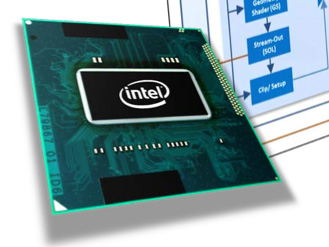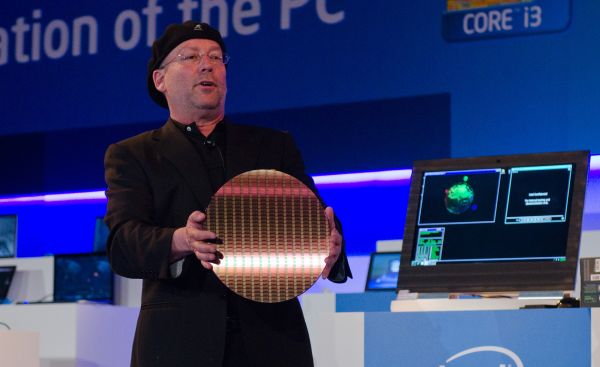Intel's Ivy Bridge Architecture Exposed
by Anand Lal Shimpi on September 17, 2011 2:00 AM EST- Posted in
- CPUs
- Intel
- Ivy Bridge
- IDF 2011
- Trade Shows
Five years ago Intel announced its ambitious tick-tock release cadence. We were doubtful that Intel could pull off such an aggressive schedule but with the exception of missing a few months here or there tick-tock has been a success. On years marked by a tick Intel introduces a new manufacturing process, while tock years keep manufacturing process the same and introduce a new microprocessor architecture. To date we've had three tocks (Conroe, Nehalem, Sandy Bridge) and two ticks (Penryn, Westmere). Sampling by the end of this year and shipping in the first half of next year will be Intel's third tick: Ivy Bridge.

Ivy Bridge (IVB) is the first chip to use Intel's 22nm tri-gate transistors, which will help scale frequency and reduce power consumption. As we already mentioned, mobile Ivy Bridge will be the first Intel CPU to bring four cores into a 35W TDP.
At a high level Ivy Bridge looks a lot like Sandy Bridge. It's still a monolithic die that features an integrated GPU. The entire die is built at 22nm, continuing Intel's march towards truly addressing integrated graphics performance. Ivy Bridge won't get rid of the need for a discrete GPU but, like Sandy Bridge, it is a step in the right direction.

Intel hasn't announced die size but transistor count has increased to approximately 1.4 billion (layout). This is up from 1.16 billion in Sandy Bridge, a 20.7% increase. With perfect scaling a 22nm Sandy Bridge die would be 47.3% the size of a 32nm die. Even with the increase in transistor count, it's a good bet that Ivy Bridge will be noticeably smaller than Sandy Bridge.
Motherboard & Chipset Support
Ivy Bridge is backwards compatible with existing LGA-1155 motherboards, although there will be a new chipset for Ivy Bridge and new motherboards to enable some features (e.g. PCI Express 3.0, native USB 3.0). The new chipset family falls under the 7-series banner. We'll see Z77, Z75, H77, Q77, Q75 and B75 available at or around launch.
| Chipset Comparison | ||||||||
| Z77 | Z75 | H77 | Z68 | P67 | H67 | |||
| CPU Support |
IVB LGA-1155 |
IVB LGA-1155 |
IVB LGA-1155 |
SNB/IVB LGA-1155 |
SNB/IVB LGA-1155 |
SNB/IVB LGA-1155 |
||
| CPU Overclocking | Yes | Yes | No | Yes | Yes | No | ||
| CPU PCIe Config |
1 x16 or 2 x8 or 1 x8 + 2 x4 PCIe 3.0 |
1 x16 or 2 x8 PCIe 3.0 |
1 x16 PCIe 3.0 |
1 x16 or 2 x8 or 1 x8 + 2 x4 PCIe 3.0 |
1 x16 or 2 x8 PCIe 3.0 |
1 x16 PCIe 3.0 | ||
| Processor Graphics Support | Yes | Yes | Yes | Yes | No | Yes | ||
| Intel SRT (SSD caching) | Yes | No | Yes | Yes | No | No | ||
| RAID Support | Yes | Yes | Yes | Yes | Yes | Yes | ||
| USB 2.0 Ports (3.0) | 14 (4) | 14 (4) | 14 (4) | 14 | 14 | 14 | ||
| SATA Total (Max Number of 6Gbps Ports) | 6 (2) | 6 (2) | 6 (2) | 6 (2) | 6 (2) | 6 (2) | ||
| PCIe Lanes | 8 (5GT/s) | 8 (5GT/s) | 8 (5GT/s) | 8 (5GT/s) | 8 (5GT/s) | 8 (5GT/s) | ||
As I mentioned above, Ivy Bridge finally supports USB 3.0 natively. The consumer 7-series chipsets feature 14 total USB ports, 4 of which are USB 3.0 capable. The CPU itself features 16 PCIe (1x16, 2x8 or 1x8 + 2x4) gen 3 lanes to be used for graphics and/or high performance IO. You will only see Gen 3 speeds on qualified motherboards. It's technically possible on 6-series motherboards but guaranteed on 7-series motherboards. The Z77 and H77 chipsets will support Intel's Smart Response Technology (SRT, aka SSD caching) which is a Z68 exclusive today.
SATA and chipset-attached PCIe slots haven't changed. Overclocking is supported on all Z-chipsets, while the H-chipset doesn't. All chipsets support Intel's HD Graphics, which is a departure from the Sandy Bridge mess where P67 didn't.










97 Comments
View All Comments
NeBlackCat - Wednesday, September 21, 2011 - link
The GPU part would be streets ahead, the drivers would be good, Tegra 3 (4..5...) on the 22nm trigate process is an absolutely mouth-watering proposition, and who knows what else could have been accomplished with the engineering effort saved on Intel GPUs and the (so far) fruitless efforts to push x86 into smart consumer devices.On the downside, there's be no AMD.
mrpatel - Wednesday, September 21, 2011 - link
The iMac 2011 27" model ships with the Z68 chipset.So the question is whether or not it would support IVY BRIDGE CPUs in it? (given that all other things like TDP etc requirements match up).
I wonder if IVY BRIDGE CPUs would require a full EFI or kernel module upgrade to be supported? (i mean i really don't care if the USB 3.0 works, but I do care about the new design, gpu performance and lower power to performance ratio compared to sandy bridge!).
caggregate - Friday, September 23, 2011 - link
So being that this is a current/future platform, what's the big deal about support for DDR3L (which as a standard was ratified in July 2010)? I realize the specs of DDR3U ("Ultra low voltage" 1.25V) are not "final" yet, but you'd think it would be implemented given that DDR3U has been available to engineers (according to Hynix/Google) since June 2010.fb39ca4 - Sunday, September 25, 2011 - link
No OpenGL 4 support? Seriously?OCguy - Tuesday, September 27, 2011 - link
Are they even trying anymore?Olbi - Tuesday, October 18, 2011 - link
I wonder why Intel add DX11, but no OpenGL 4? Both are needed by developers of apps and DX11 isnt need by allmost all app. OpenGL 4 is needed by Linux desktop like KDE 4, GNOME, Xfce and others. So why Intel still doesnt support it.tkafafi - Tuesday, March 20, 2012 - link
Why do the new intel chipsets (series 7) still contain so many (10) usb2 ports ? Would any PC/laptop manufacturer chose to use a usb2 port instead of anavailable usb3 port from the chipset ? for e.g would they use 2 usb2 + 2usb3 instead of 4 usb3 from the chipset ?I know PC manufacturers are using this configuration (2 usb2 + 2 usb3) because now they need to support usb3 through an external controller so they are saving cost by using a 2 port controller. But once series 7 chipsets arrive with native usb3 support, there would be no cost advantage to do this. Is this to derisk any interoperability issues with older usb2 devices (i.e if for some reason usb3 ports don't work well with some existing usb2 devices) ?
Thanks